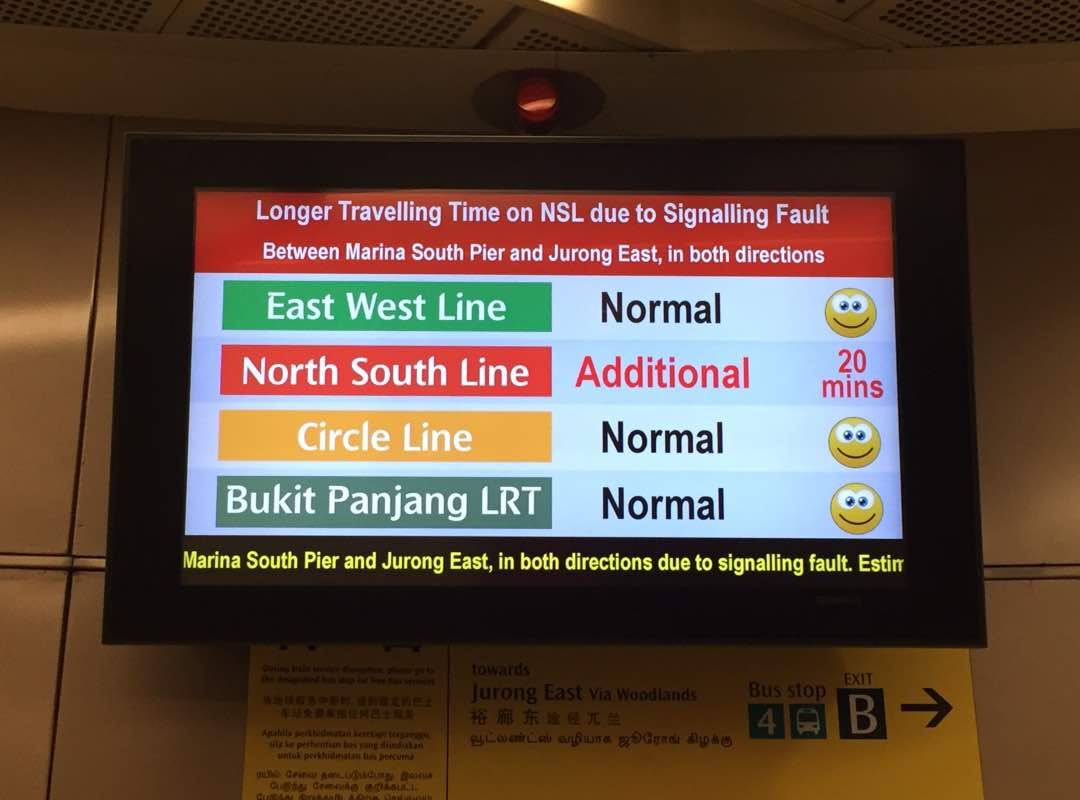As you might know, if you are a plebeian like us who happens to take the MRT on the North-South and East-West lines, there have been a number of delays and even at some points disruptions over the past month or so.
We first caught wind of this happening on June 1, where the excuse reason given was a vague "new signalling system checks":
[NSL] Due to new signalling system checks, pls add 20mins travel time between #MarinaSouthPier & #JurongEast both bounds. We are sorry.
— SMRT Corporation (@SMRT_Singapore) June 1, 2017
Now of course, as we asked in this article we wrote that day, why on earth would SMRT conduct signal system checks during the peak hour of train service???
It took some time, but we now have the answer.
And as it turns out, it's quite a long story, which we'll try to help you break down in a simplified list of questions we think you might have on your mind, and their answers:
1) Simi signalling system?
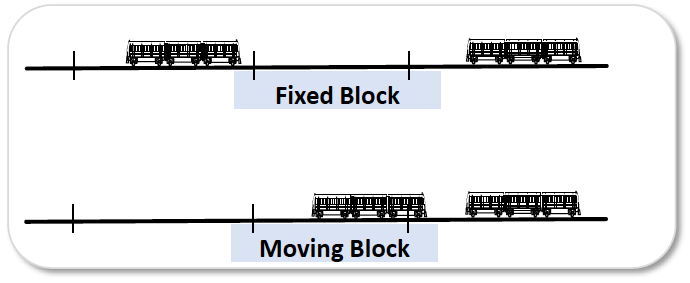 Image courtesy of LTA
Image courtesy of LTA
One of the key components of an MRT network is its signalling system. The "explain like I'm five" account of what that is this: it allows trains to talk to one another, the stations they stop at and the overall control centre to make sure they don't bump into one another or end up stuck together at one station.
Since the North-South and East-West Lines opened in 1987 (the East-West Line was named the East-West Line two years later), both have been running on a 30-year-old signalling system called a "fixed block".
In the fixed block system, a given stretch of tracks is divided into "blocks" or lengths, and so trains must observe a minimum fixed distance between one another, calculated by those blocks.
This means that even if only the tiniest part of a train (like say, 5cm of the last carriage) happens to be sitting on the edge of a block at any one point, the next train will not be allowed to occupy that block, or the next block of tracks, for instance.
Now that we're in 2017, it's high time for a change. The London and Taipei metro systems use a new system called the "moving block", which relies on real-time communication of the precise location of a train — as opposed to being traced via the "blocks" they are situated on at any point in time.
This, says the Land Transport Authority and SMRT, will help to pack more trains closer together, and therefore carry more passengers more efficiently.
Also, the new signalling system will hopefully cut our waiting time for trains from 120 seconds (during peak hour) to 100 seconds on average.
[related_story]
2. Why change the North-South and East-West lines only ah?
Because they're old. And also carry the most passengers every day.
And all the other train lines we have now (i.e. the North-East Line, the Circle Line, the Downtown Line and also the future Thomson-East Coast Line) are on the new signalling system. So of course, it makes sense to upgrade the two main lines almost everyone takes, right? To benefit the most number of people?
3. Great! So just change la. Very difficult meh?
In short: yes, very. In a group briefing with members of the media on Friday morning, big guns from the LTA, SMRT and Thales, the makers of the new signalling system, took great pains to explain to us just how tedious the entire process is.
Take a look at the numbers, for instance. To rejig the signalling systems on the two lines requires the installation of equipment to
- 95km of train tracks,
- 141 trains,
- 54 train stations,
- 1 main operation control centre, and
- 3 depots, from which trains are deployed.
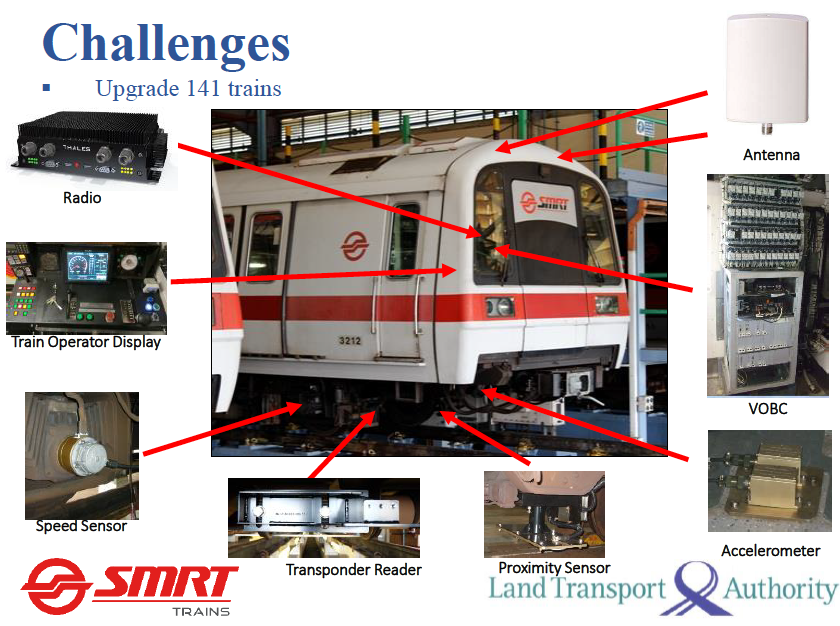 Images courtesy of LTA
Images courtesy of LTA
On each train, for instance, the equipment you see above has to be installed at both ends of each train, which incidentally happens to be 141m long (random trivia).
Along the entire stretches of tracks that cover these two lines — adding up to a total of 95km — the following equipment must be put in place at intervals:
For tunnels:
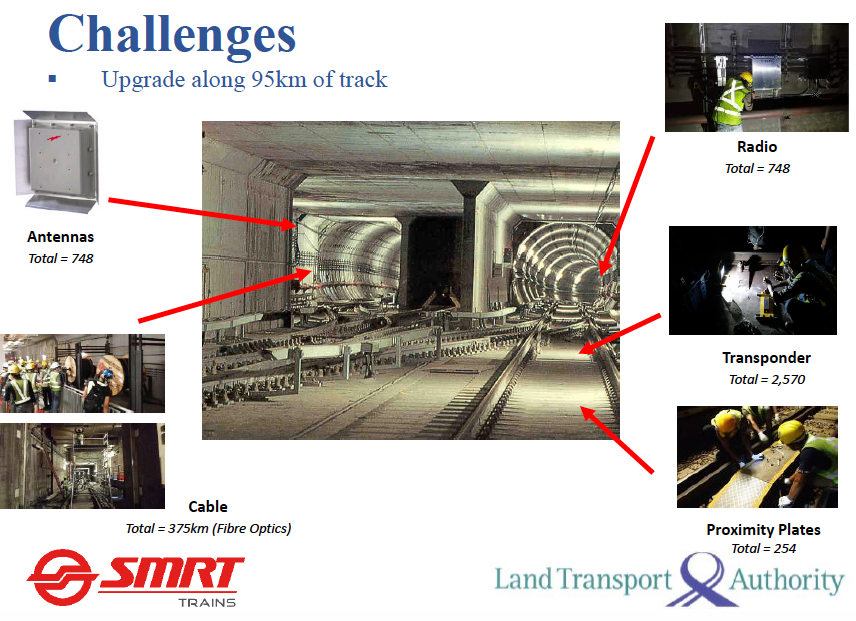 Images courtesy of LTA
Images courtesy of LTA
And for above-ground tracks:
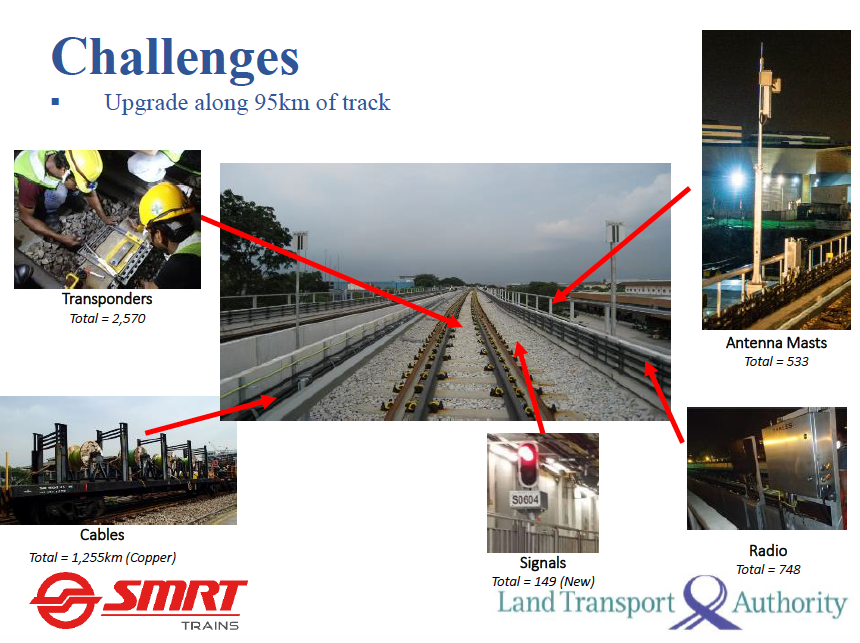 Images courtesy of LTA
Images courtesy of LTA
And for train stations, this clunky equipment on the left below needs to be changed out to this sleeker one on the right:
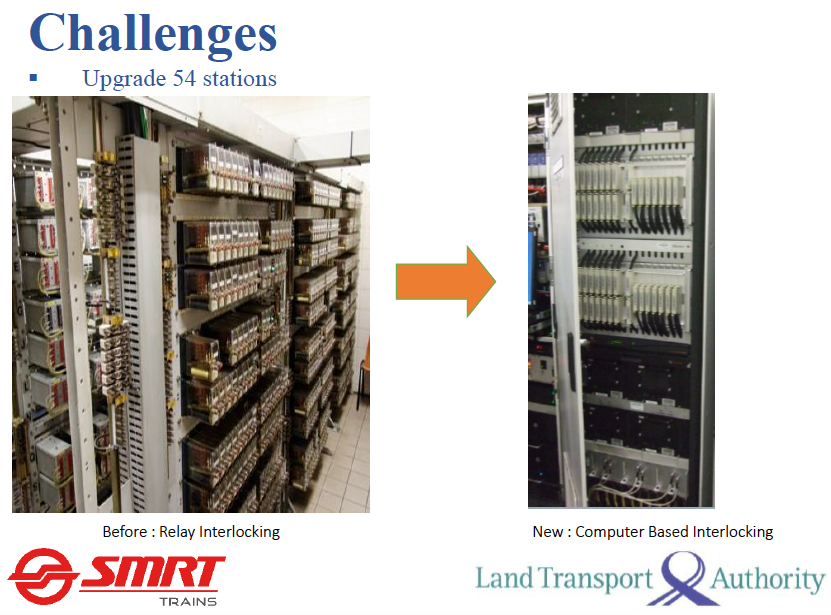 Images courtesy of LTA
Images courtesy of LTA
All this, ideally, would be done outside of regular train operating hours.
Unfortunately, the available time that the team of engineers from LTA, SMRT and Thales can work is a golden three-hour period: from 1:30 to 4:30am only. Beyond that time, stations and trains need to prepare for the next day's service, as the first trains get deployed from before 5:30am.
4. Okay, that's dandy. So why were/are they testing the new signalling system during peak hours on the North-South Line?!
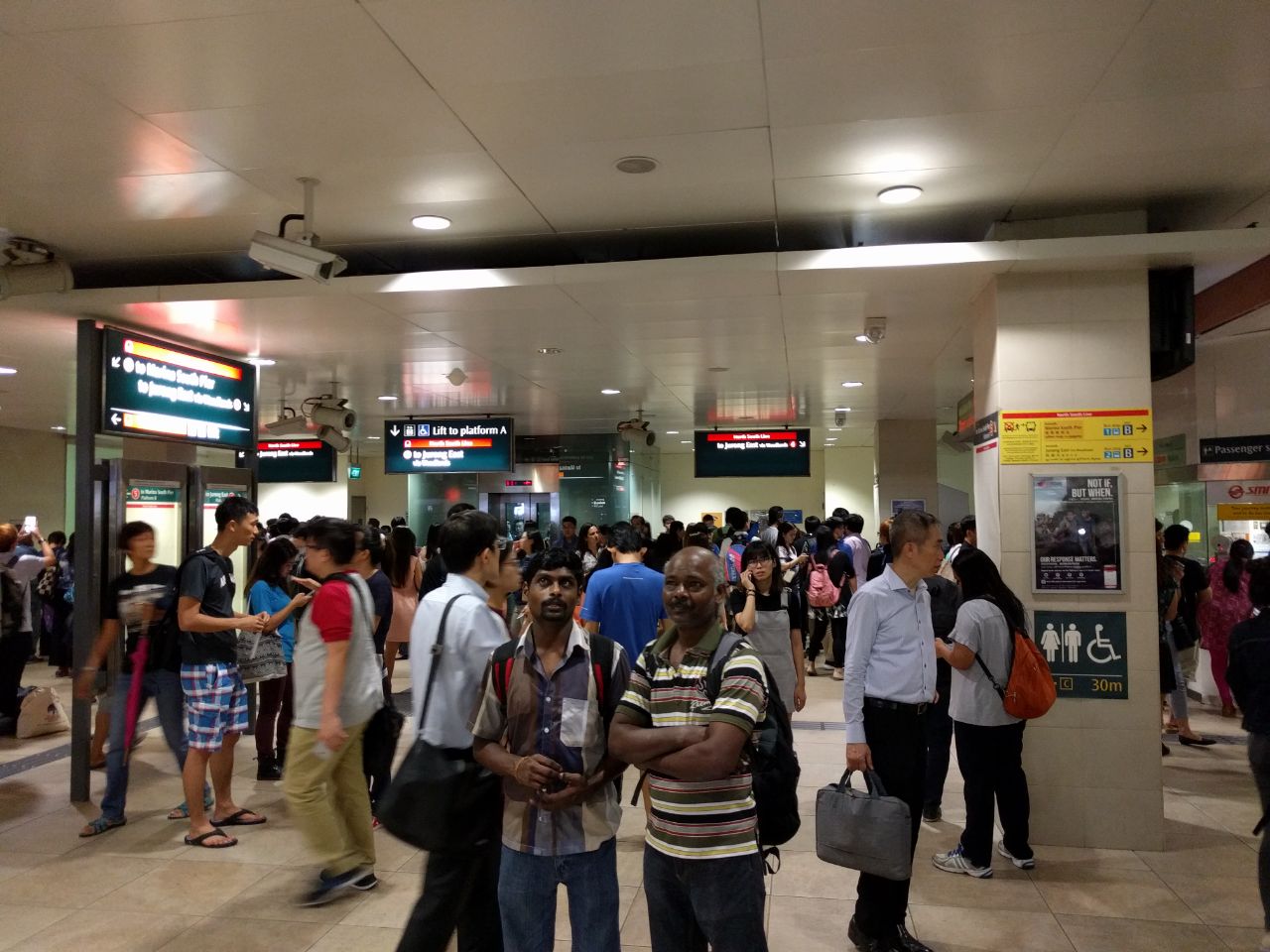 Photo by Merrill Tang
Photo by Merrill Tang
Sure, it did seem like quite an idiotic thing to do to most of us, especially on June 1 and 2. But here's the backstory — a little of it was explained in this blog post we wrote about previously, but there's a bit more to it:
- LTA and SMRT first started testing the new signalling system in the 1:30-4:30am period (which they call "engineering hours"). They ran more than 1,300 tests on it, working with up to 40 trains on the system simultaneously. None of these tests yielded significant problems they could not solve.
- Then, they turned on the new system in tandem with the "fixed block" one, to record data and to monitor its reliability, during regular operating hours. So the new system wasn't controlling the trains, but merely mimicking the existing system while the latter was in control. All looked good here too.
- By late March, they tried 10 rounds of testing the new signalling system between 11pm and post-midnight, when the train service ends.
- They also did six rounds of testing the new system on entire Sundays, loading it up beyond usual capacity by increasing it from 41 trains to 61 — the usual train load on weekdays. No major issues were encountered during these tests either.
And it was only after they went through all of the above that they decided it was time to bring the new signalling system on to full-day daily operations on the North South Line.
(Bear in mind, by the way, that the East-West Line's new signalling system is still in progress of being built. Testing for that will start after the North-South Line's teething issues have stabilised.)
This, say the LTA's big wigs, is unavoidable — the new signalling system must be stress-tested at all hours of train operation to ensure that it really will work better and stably.
And they did as many possible tests prior to putting it on full day service operation as they could beforehand. So fyi, they're not as idiotic as you might think.
5. Okay, so what now?
We pressed the LTA and SMRT bigwigs for estimations and projections on how long it will take for the new signalling system to stabilise.
They explained to us that part of the reason it's so tough is because they're retaining the old signalling system and making sure it's still functional, alongside trying to make sure the new one works well. That way, it will always be an effective backup and fallback in the event the new system fails.
And that's how Singapore does it because, well, we humji and also kiasu, which to their minds makes more sense than to just jump to the new system right away without making sure everything's working fine and well first.
So here's the hoped timeline for the North-South and East-West lines:
- For the new signalling system to stabilise on the North-South Line: 4-6 months
- For the old signalling system on the North-South Line to retire: a year total (from May 28, when full day operational testing started)
For the East-West Line, the bigwigs say they're hoping to be ready to start testing by the December holidays.
And that, friends, is the story of why we can expect to see more signalling system-caused delays and disruptions, both on the North-South and East-West lines.
The end.
Here is a totally unrelated but equally interesting article:
Simple changes to your army boy lifestyle to help you save some money
Top file photo by Grace Huan
If you like what you read, follow us on Facebook, Instagram, Twitter and Telegram to get the latest updates.
